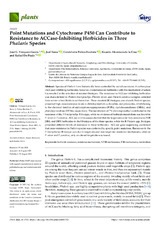Mostrar el registro sencillo del ítem
Point Mutations and Cytochrome P450 Can Contribute to Resistance to ACCase-Inhibiting Herbicides in Three Phalaris Species
| dc.contributor.author | Vázquez-García, José Guadalupe | |
| dc.contributor.author | Torra, Joel | |
| dc.contributor.author | Palma-Bautista, Candelario | |
| dc.contributor.author | Alcántara-de la Cruz, Ricardo | |
| dc.contributor.author | Prado, Rafael de | |
| dc.date.accessioned | 2021-09-29T07:50:10Z | |
| dc.date.available | 2021-09-29T07:50:10Z | |
| dc.date.issued | 2021 | |
| dc.identifier.uri | http://hdl.handle.net/10396/21708 | |
| dc.description.abstract | Species of Phalaris have historically been controlled by acetyl-coenzyme A carboxylase (ACCase)-inhibiting herbicides; however, overreliance on herbicides with this mechanism of action has resulted in the selection of resistant biotypes. The resistance to ACCase-inhibiting herbicides was characterized in Phalaris brachystachys, Phalaris minor, and Phalaris paradoxa samples collected from winter wheat fields in northern Iran. Three resistant (R) biotypes, one of each Phalaris species, presented high cross-resistance levels to diclofop-methyl, cycloxydim, and pinoxaden, which belong to the chemical families of aryloxyphenoxypropionates (FOPs), cyclohexanediones (DIMs), and phenylpyrazolines (DENs), respectively. The metabolism of 14C-diclofop-methyl contributed to the resistance of the P. brachystachys R biotype, while no evidence of herbicide metabolism was found in P. minor or P. paradoxa. ACCase in vitro assays showed that the target sites were very sensitive to FOP, DIM, and DEN herbicides in the S biotypes of the three species, while the R Phalaris spp. biotypes presented different levels of resistance to these herbicides. ACCase gene sequencing confirmed that cross-resistance in Phalaris species was conferred by specific point mutations. Resistance in the P. brachystachys R biotype was due to target site and non-target-site resistance mechanisms, while in P. minor and P. paradoxa, only an altered target site was found. | es_ES |
| dc.format.mimetype | application/pdf | es_ES |
| dc.language.iso | eng | es_ES |
| dc.publisher | MDPI | es_ES |
| dc.rights | https://creativecommons.org/licenses/by/4.0/ | es_ES |
| dc.source | Plants 10(8), 1703 (2021) | es_ES |
| dc.subject | Herbicide resistance | es_ES |
| dc.subject | Resistance mechanisms | es_ES |
| dc.subject | NTSR mechanisms | es_ES |
| dc.subject | TSR mechanisms | es_ES |
| dc.subject | Metabolism | es_ES |
| dc.title | Point Mutations and Cytochrome P450 Can Contribute to Resistance to ACCase-Inhibiting Herbicides in Three Phalaris Species | es_ES |
| dc.type | info:eu-repo/semantics/article | es_ES |
| dc.relation.publisherversion | https://doi.org/10.3390/plants10081703 | es_ES |
| dc.relation.projectID | Gobierno de España. AGL2017-83325-C4-2-R | es_ES |
| dc.relation.projectID | Gobierno de España. RYC2018-023866-I | es_ES |
| dc.rights.accessRights | info:eu-repo/semantics/openAccess | es_ES |

